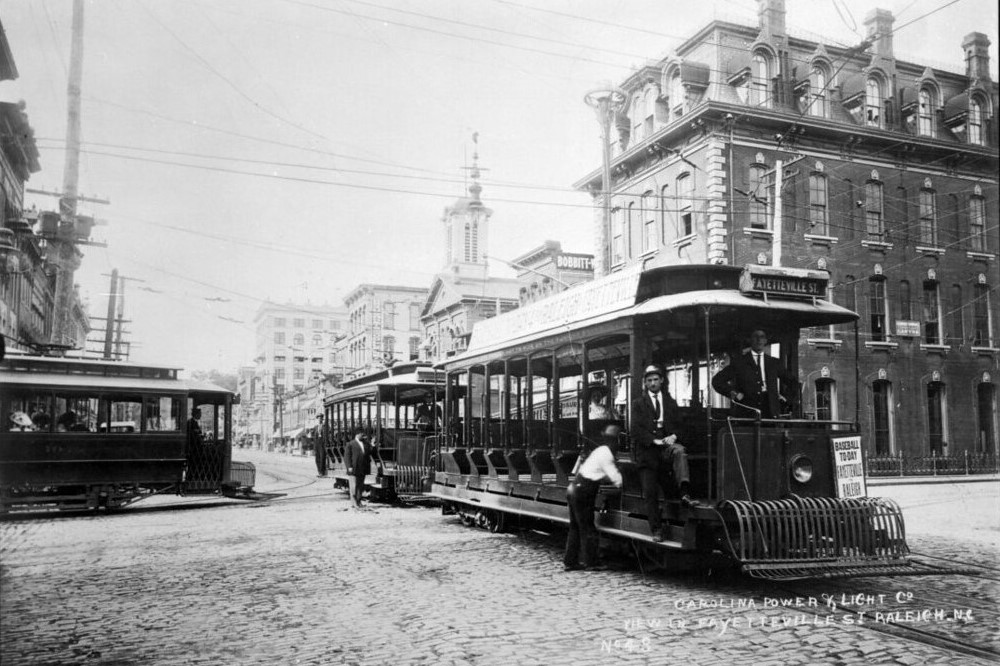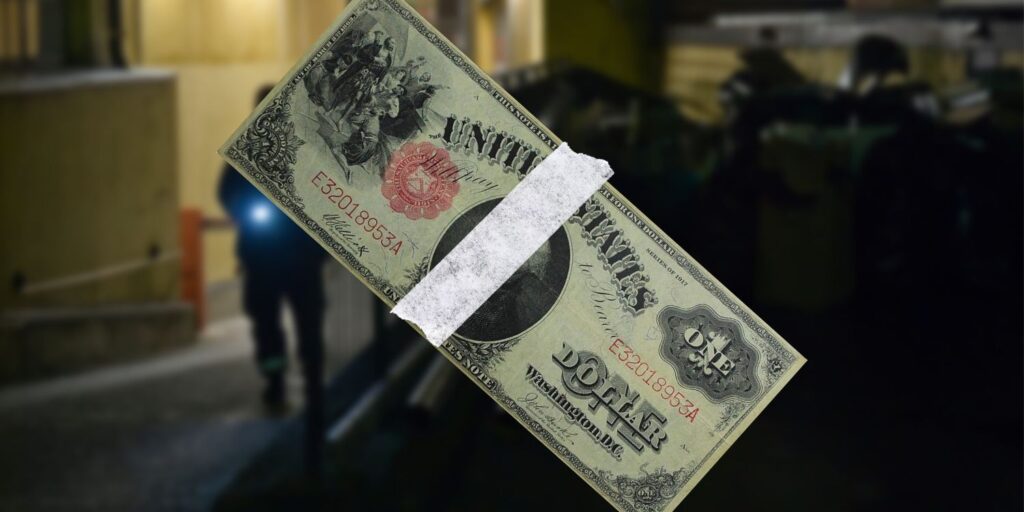Shortly before 6:00 a.m. on Saturday, August 25, 1917, Mr. C.C. Beaver, foreman for the street car barns and shops of the North Carolina Public Service Company in Salisbury, NC, walked into work and found a nightmare. The safe containing the money from the previous day’s fares was broken open and empty. On further investigation, he found the bloody, battered body of the night watchman, a Black man named Abel Harris, lying on the floor of car No. 62.
Harris had been brutally beaten. There were deep gashes across the front and back of his head, over his temples, and under his chin. He had also been stabbed in the head and neck. A tooth was found about three feet away. It was unclear if it belonged to the victim or the killer.
His death certificate noted the cause of death as “Found dead, murdered by parties unknown. Beat on the head with a blunt iron known as a switch key.”
Harris was a big, powerfully built man, and whoever killed him took no chances. Harris’ flashlight was by his side, and the front of it was described as “battered.” The police believed he had used it to defend himself. From the amount of work Harris had completed before being killed and the temperature of his body when found, it was surmised that the crime occurred at about 2 a.m. Harris was 30 years old and had a wife and three children. His widow received a $500 payment through the company’s newly instituted employee insurance plan.
Once he pulled himself together, Beaver immediately notified the authorities. I have a feeling the trolleys ran late that Saturday. Sheriff J. H. Krider, his deputies, and Police Chief J. Frank Miller were soon on the scene. They attempted to use bloodhounds to track the assailant, but the dogs could not find the trail.
Harris worked as a track greaser. He was substituting for the regular night watchman, a one-legged Black man named Baxter Cain, who had asked for the night off so he could stay home with his sick wife.
A Theory of the Case
At noon, the company’s General Manager, Ralph Hole, arrived by automobile and got the facts of the case from Beaver and the police. He immediately offered a $100 reward for information leading to the arrest and conviction of the person or persons responsible for the murder and robbery.
Hole had three theories about the crime and one question. He believed there was more than one intruder; they were inexperienced criminals, and they possessed prior knowledge of the trolley barn’s layout, including the safe’s location. The question weighing on his mind was why the thieves had struck on a Friday night. Saturday receipts were always more than any weekday. Two of his three theories were right, and he could have never imagined the answer to his question.
When Cain returned to the street car barns to start his shift Saturday night, Police Chief Miller was there to arrest him for the murder of Abel Harris and the robbery. Baxter Cain had been in a bind. He owed a balance of $50 on a new wooden leg, and if he didn’t make payment by Saturday noon, the artificial limb would be returned to the manufacturer. He had attempted to get a loan from several people, but everyone he approached turned him down.
So he came up with a plan: a callous, cruel, cunning plan. He would get someone to work in his place, kill them, rob the safe, and use the money to pay for the leg. And you thought your coworkers were difficult to deal with.
The day after the murder, Cain had gone to the Yadkin Hotel, which was holding the leg, and paid the clerk, C. B. Denny, the $50, mostly in one-dollar bills, 50 and 25 cent pieces. Denny, who was aware of the murder and robbery, reported the suspicious transaction.
Torn Dollar Seals Cain’s Fate
From the Monday, August 27, 1917, Salisbury Post:
“One of the bills had been torn in two and was pasted together with a piece of white paper. This bill was identified by one of the street car conductors as one he had taken in Friday.”
With Cain in custody, the investigation kicked into high gear, and the net quickly closed around him. In the hayloft of Cain’s barn, the police found $27.20 in quarters, dimes, and nickels tied up in a cloth. This money along with the $50 closely matched the $78.20 stolen.
On Sunday, officers followed tracks left by Cain’s mule to a branch behind the barn, and hidden in a hole in the streambank they found car operators’ receipts and transfers, along with a piece of cloth that had been used as a streamer on the side of a streetcar advertising a ball game at Spencer, a nearby town.
During the coroner’s inquest, it was revealed that when Cain requested the night off, he recommended Mitchell McCall, a small, slender man, to take his shift. However, Beaver opted for Harris instead. As it turns out, killers, much like beggars, can’t be choosers.

Baxter Cain’s trial began on Tuesday, September 11, in Rowan County Superior Court and got off to a rough start. Judge E. B. Cline of Newton, NC, asked each juror if they had any objections to imposing the death penalty based entirely on circumstantial evidence, which would be the outcome if Cain was found guilty. All 12 jurors agreed that they did not, and then, five minutes into the trial, juror M. A. Goodman raised his hand and stated that he could not convict a man of first-degree murder based solely on circumstantial evidence. Judge Cline was not amused. A mistrial was declared. A new jury was selected, and the court continued its business with only a one-hour delay.
On Wednesday, the evidence was presented, and Cain took the stand on his own behalf, contending that he knew nothing about the murder. In addition, to the evidence found at or near Cain’s residence, a witness testified that he had seen a man riding a mule near the crime scene at 2:00 a.m. on the night of the murder. It had been too dark for him to recognize the rider, but he identified the mule as being the same size and color as the one owned by Cain.
Judge Cline charged the jury, and deliberations began Thursday at 1:00 p.m. The jury brought in a verdict of guilty of murder in the first degree on Friday at 10:00 a.m. On Friday, September 15, Judge Cline sentenced Cain to die in the electric chair.
The Saturday, September 15, 1917, The Salisbury Post’s report concluded with the following:
“The condemned man stood up during Judge Cline’s talk and showed not a quiver, although the half-way smile that had been on his face during the coroner’s investigation and afterward disappeared, and he had a faraway look. He walked back to his seat and then was taken in charge by officers, not murmuring a word the whole time.”
An Unconventional Execution
Baxter Cain was one cool customer and a cold-blooded killer. He was executed in the electric chair at Central Prison, Raleigh, NC, on Friday, September 13, thirteen months after the murder. He never confessed to committing the crime.
The, Saturday, September 14, 1918 Greensboro Daily News reported:
One legged, he entered death chamber on a crutch, backed up to the chair, threw his crutch away, and leaped into the seat.
W. T. Bost, Raleigh Correspondent, described the execution saying:
“It was, in minor respects, the most spectacular electrocution of three dozen or more now recorded in the annals of death out there. Never had been anybody named Cain electrically baked for killing anybody named Abel. Never had a victim single-footed his pilgrimage of death and with such marked aplomb as this Rowan county man who never saw a hand that he did not think was raised against him.”
Bost tells us that the current was applied three times and that “and when the current struck him, one felt the floor quiver.” Cain’s death certificate tells us that the electrocution took two and a half to three minutes. He remained defiant to the end.
(Editor’s note: In some documents and newspapers, the victim’s name was given as Abell Harris.)
If you enjoyed this story, please consider sharing it with a friend or clicking on one of the social sharing icons above or below the post. Comments are always welcome. If you have a topic or crime you’d like to see covered, email me at editor@blueridgetruecrime.com.
Check out my new book, Blood on the Blue Ridge: Historic Appalachian True Crime Stories 1808-2004, cowritten with my friend and veteran police officer, Scott Lunsford on Amazon. Buy it here!
I also have a Substack newsletter, A History of Bad Ideas, where I write about poorly thought-out ideas, misguided inventions, and dire situations throughout history created by people who frankly should have known better.
Sources
State v. Cain: Spring Term, 1918, North Carolina Supreme Court
Salisbury Post, NC, Saturday, August 25, 1917, Page 1, “Watchman at Street Car Barns Foully Murdered – Safe Robbed of Contents”
Charlotte Observer, Sunday, August 26, 1917, Page 3, “Double Crime in Salisbury”
Salisbury Post, NC, Monday, August 27, 1917, Page 1, “Baxter Cain Held on Murder Charge”
Charlotte Observer, Tuesday, August 28, 1917, Page 3, “Evidence Accumulates Against Baxter Cain”
Salisbury Post, NC, Friday, August 31, 1917, Page 1, “Baxter Cain Held in Harris Murder”
Salisbury Post, NC, Saturday, September 15, 1917, Page 1, “Baxter Cain to Die November 9”
Greensboro Daily News, NC, Saturday, September 14, 1918, Page 1 “Baxter Cain Hobbles Down Death Lane on One Foot and Crutch”

